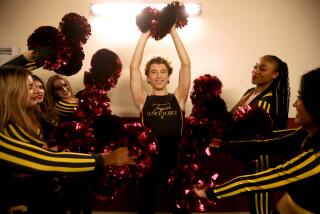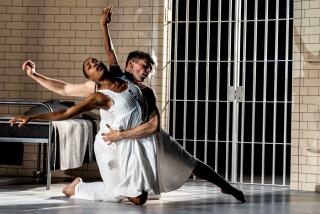The thrill is gone
Not so long ago, the male duet represented the last word in provocative intimacy on dance stages -- a controversial fusion of new choreographic techniques and rapidly shifting social attitudes regarding men in general and homosexuals in particular. Today, guys dancing together are becoming the new Big Yawn -- a cliche almost as inescapable as silent screams, women lashing their waist-length hair or jesters who jump but never jest.
Besides the gay-identified choreographers still intrigued by the male duet (Bill T. Jones, for instance), middle-of-the-road companies from Pilobolus to the Alvin Ailey American Dance Theatre rush to throw their hunks into one another’s arms. There’s even an aerial one in the new Cirque du Soleil extravaganza “Varekai” performed by brothers. And locals from Lula Washington to Michael Mizerany also assign pairs of men to play choreographic patty-cake in acknowledgment of the status quo. Queer guys for straight eyes: That’s what male duets most often supply, whatever the offstage realities of the dancers’ lives. But it’s all so uninventive now, so reflexive, so ... wimpy.
Obviously, the proliferation of homocentric TV series robs the millennial male duet of its effect as a novelty act. But full acceptance of homosexuality is far from won, the AIDS crisis is far from over, and guys still befriend and/or betray one another. So the deepest expressive issues of the male pas de deux remain as powerful as ever. What’s missing, most of the time, is a fresh choreographic vision: the moves, not the manpower.
The double game
There always have been buddy-buddy male duets (Gene Kelly dancing alongside Frank Sinatra or Donald O’Connor, for example) and those depicting combat. But dances that confronted societal taboos about men touching came from a completely different impetus, and many of the best known have played a double game to undercut the prejudice against anything that might be construed as having a gay agenda.
That double game involved showing one thing while saying another. For instance, Gerald Arpino’s 1974 dance drama “The Relativity of Icarus” centered on a daringly sensual, gymnastic male duet, mirrored to multiply the men’s horizontal interplay from many angles. At times, it looked like an uptown bathhouse fantasy, but the plot (as minimal as the costuming) declared that Joffrey Ballet hunk Ted Nelson and heartthrob Russell Sultzbach were playing father and son -- Daddy and Junior -- and that all their sweaty grappling represented a paternal flying lesson.
Nobody believed it, of course, not for an instant, not even when Arpino angrily insisted. And the same disbelief greeted the hetero payoff to what might be the most seductive male duet yet choreographed: the one midway through Lar Lubovitch’s 1986 ensemble showpiece “Concerto Six Twenty-Two.” Mercurial and confessional, the choreography explored issues of male bonding -- and, implicitly, male romance -- with such extraordinary sensitivity that you remembered the sense of transcendent physical and emotional rapport between these men long after you forgot that they were paired off with women in the work’s pat, formal finale.
With that ending, Lubovitch’s gambit seemed something like the old Hollywood formula for religious epics: two hours of the forbidden, 10 minutes of repentance. Indeed, you could argue that the hypocrisy of such works was exactly what made them controversial -- that critics and audiences got angry trying to reconcile the disparity between the staid pretexts and audacious subtexts.
Certainly the deliberately lurid male couplings in Martha Graham’s 1983 dance drama “Phaedra’s Dream” generated no such debate, arguably because Graham’s pretext and subtext were identical: an uncompromising investigation of hetero- and homo-prurience. And when Jones (a pioneer of the autobiographical male duet) danced in work after work with his lover and collaborator, Arnie Zane, beginning in the early 1970s, reviewers’ reactions seemed more focused on their racial difference (Jones, black; Zane, white) than any other factor.
As former President William Jefferson Clinton could tell you, sex alone doesn’t necessarily ignite controversy. Denial always does.
Hiding behind metaphor
Legal realities outside the U.S. often made the pretext/subtext game a necessity. Russian choreographer Boris Eifman premiered his biographical epic “Tchaikovsky: the Mystery of Life and Death” in 1993, years before his country decriminalized homosexuality. As a result, the most blatant homoeroticism in the work hid behind metaphor: a male orgy with the participants representing fantasy playing cards, and a series of hot, intense male duets that Eifman said physicalized the conflict between Tchaikovsky’s uptight public persona and his sensuous inner nature.
Looking at the stage, you saw (as with Arpino, Lubovitch, Graham, etc.) two guys all over each other. Reading the program synopsis, you learned they were merely doubles, doppelgangers, nothing to warrant a visit by the sex police.
Using similar tactics with his radically reconceived 1995 “Swan Lake,” British choreographer Matthew Bourne circumvented a law against promoting homosexuality by issuing lots of statements that this wasn’t a gay ballet -- no, sir, no way -- but rather a study of interspecies hero worship.
Happily, Bourne’s spectacular duets for his prince and male swan left his demurrals in the dust -- and it turned out that audiences wanted this “Swan Lake” to be every bit as gay as it looked. So Bourne shut up, came out, and within five years was awarded an OBE (officer of the Order of the British Empire) by the very same Windsors whom he’d mocked in the comedy scenes of the work.
However unfortunate some of these choreographers’ verbal, narrative or structural equivocations now appear in the era of “Will & Grace” and “Boy Meets Boy,” it must be noted that Bourne, Eifman, Lubovitch and even the ‘70s Arpino were important creative artists, expanding freedom of expression in their male duets. Moreover, whatever their offstage strategies or subterfuges, their choreographies brilliantly defined the central partnering issues of the male duet that many recent attempts have ignored to their cost.
Contact improvisation
Although sexual politics played the largest role in the emergence of the male duet as an end-of-the-century subgenre, the role of contact improvisation shouldn’t be underestimated. Developed by modern dancer Steve Paxton and others in the early 1970s, it sought a free, flowing interchange of energy and weight, with friction, momentum and trust between partners becoming more or less prominent as the dancing continued.
Some contact improvisation specialists consider what they do an art, some a sport, but however you classify it, it’s had an incalculable effect on the way contemporary choreographers develop their pieces. And because it’s usually more rewarding with partners of equal weight and upper-body strength, same-sex hookups always have been common and take place without any assumptions about the participants’ sexual preferences.
So for the last 30 years, jocks have been jumping on one another, touching and being touched, lifting and being lifted, getting into other men’s energy without pretending that they’re in love with anybody or that the fate of nations depends on who’s the last man standing. And their trailblazing movement experiments have shown how exciting dance partnerships can be when power, dominance and the other codified and stereotyped relationships of the male-female duet suddenly are up for moment-by-moment renegotiation.
The volatile trapeze duets in Lloyd Newson’s “Enter Achilles” for DV8 Physical Theatre (1995) and Alison Chase’s “Ben’s Admonition” for Pilobolus (2002) brilliantly exploited male upper-body strength while undercutting glossy, predictable cirque-style formulas for aerial virtuosity. Anything could happen here -- outbursts of anger, acts of valor, a sudden, collaborative experience of perfect physical freedom. And that’s what is missing in so many recent male duets: the sense of physical, kinetic risk that leads to such breakthroughs.
Too many male duets these days seem strangely unmanly: choreographed by Bourne’s repressed prince, not his passionate swan, or by Eifman’s uptight Tchaikovsky, not his free-spirited double. Two guys glumly staring into each other’s eyes while they feebly sway and dip may still make some kind of sociopolitical statement, but it’s a bore as dance and an utter negation of male energy at its most potent and heroic.
Segal is The Times’ dance critic.
More to Read
The biggest entertainment stories
Get our big stories about Hollywood, film, television, music, arts, culture and more right in your inbox as soon as they publish.
You may occasionally receive promotional content from the Los Angeles Times.










